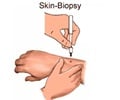
In their new study, Sliman Bensmaia from the University of Chicago, two former undergraduates and a postdoctoral scholar in his lab-Matthew Best, Emily Mackevicius and Hannes Saal - found that the skin is also highly sensitive to vibrations, and that these vibrations produce corresponding oscillations in the afferents, or nerves, that carry information from the receptors to the brain.
The precise timing and frequency of these neural responses convey specific messages about texture to the brain, much like the frequency of vibrations on the eardrum conveys information about sound.
Neurons communicate through electrical bits, similar to the digital ones and zeros used by computers.
"One of the big questions in neuroscience is whether it's just the number of bits that matters, or if the specific sequence of bits in time also plays a role. What we show in this paper is that the sequence of bits in time does matter, and in fact for some of the skin receptors, the timing matters with millisecond precision," Bensmaia said.
Researchers have known for years that these afferents respond to skin vibrations, but they studied their responses using so-called sinusoidal waves, which are smooth, repetitive patterns. These perfectly uniform vibrations can be produced in a lab, but the kinds of vibrations produced in the skin by touching surfaces in the real world are messy and erratic.
Advertisement
When the team analyzed the data recorded from the rhesus macaques, they found that not only did the nerve oscillate at the frequency of the vibrations, but they could also predict how the human subjects would perceive vibrations based on the neuronal responses to the same frequencies in the macaques.
Advertisement
"It's actually true for the kinds of stimuli that you would experience in everyday life," he said.
What this means is that given a certain texture, we know the frequency of vibrations it will produce in the skin, and subsequently in the nerve. In other words, if you knew the frequency of silk as your finger passes over it, you could reproduce the feeling by stimulating the nerves with that same frequency without ever touching the fabric.
The study has been published in the Journal of Neuroscience, Bensmaia.
Source-ANI









